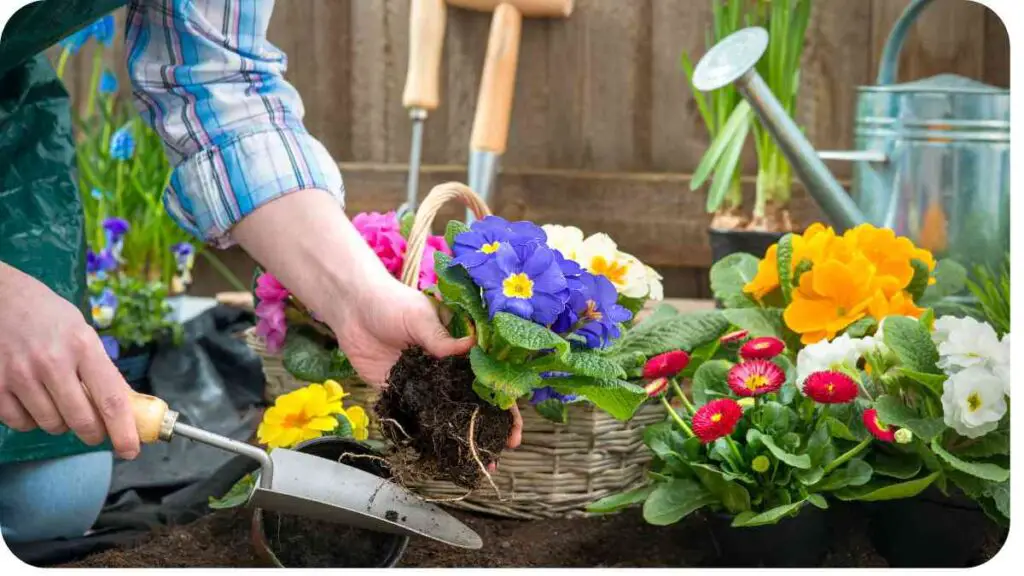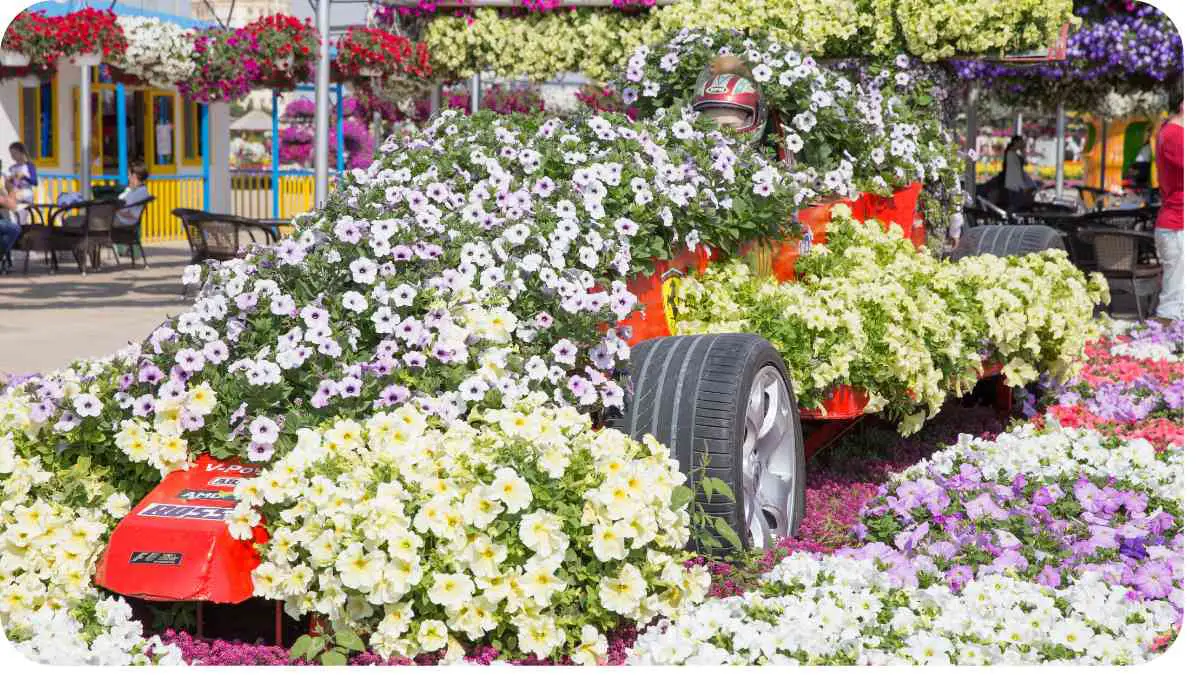Welcome to the world of cutting flower gardens! If you’re looking to add a burst of color and fragrance to your outdoor space while enjoying a constant supply of fresh blooms for your home, you’re in the right place. In this guide, we’ll explore everything you need to know to create your own blooming oasis right in your backyard.
| Key Takeaways |
|---|
| 1. Choose the right plants for your cutting flower garden based on their suitability for cutting and blooming season. |
| 2. Plan your garden layout, considering factors like sunlight exposure, color scheme, and succession planting. |
| 3. Prepare the soil by testing and amending as needed to create a healthy growing environment for your flowers. |
| 4. Care for your cutting flower garden by watering, fertilizing, deadheading, and providing support for tall plants. |
| 5. Harvest your blooms at the right time and extend the flowering season through proper maintenance and plant selection. |
| 6. Incorporate sustainable gardening practices to minimize environmental impact and promote long-term garden health. |
2. Choosing the Right Cutting Flower Garden Plants

When selecting plants for your cutting flower garden, it’s essential to choose varieties that not only produce beautiful blooms but also hold up well as cut flowers. Here are some popular options to consider:
Discover the vibrant charm of local floral artistry in Fort Lauderdale. With expertly crafted arrangements, our florists bring beauty to every occasion, transforming spaces into enchanting gardens.
| Flower Variety | Ideal Growing Conditions | Blooming Season | Special Care |
|---|---|---|---|
| Roses | Full sun, well-draining soil | Spring to fall | Regular deadheading |
| Zinnias | Full sun, fertile soil | Summer to fall | Deadheading and occasional fertilization |
| Dahlias | Full sun, moist soil | Summer to fall | Stake tall varieties |
| Sunflowers | Full sun, well-draining soil | Summer to fall | Support for taller varieties |
3. Planning Your Cutting Flower Garden
Before diving into the soil, take some time to plan out your cutting flower garden. Consider the following factors:
- Location: Choose a spot in your garden that receives plenty of sunlight, as most cutting flowers thrive in full sun. Additionally, ensure easy access to water for regular irrigation.
- Layout: Sketch out a rough design of your garden beds, considering factors like the size and shape of the area, pathways, and any existing structures or features you want to incorporate.
- Color Scheme: Think about the color palette you want for your garden. You can go for a harmonious blend of colors or create a bold contrast by mixing complementary hues.
- Succession Planting: Plan for succession planting to ensure a continuous harvest of blooms. This involves staggering the planting of different flower varieties so that as one fades, another is ready to take its place.
4. Preparing the Soil
Healthy soil is the foundation of a thriving cutting flower garden. Follow these steps to prepare your soil:
- Test the Soil: Conduct a soil test to determine its pH level and nutrient content. Most cutting flowers prefer a slightly acidic to neutral pH (around 6.0 to 7.0).
- Amend the Soil: Based on the results of your soil test, amend the soil as needed. Add organic matter such as compost, well-rotted manure, or leaf mold to improve soil structure and fertility.
- Loosen the Soil: Use a garden fork or tiller to loosen the soil to a depth of at least 12 inches. This will improve drainage and aeration, allowing plant roots to penetrate easily.
5. Planting Your Cutting Flower Garden

Now it’s time to get your hands dirty and start planting! Follow these tips for successful planting:
- Spacing: Pay attention to the spacing requirements of each plant variety to ensure they have enough room to grow and access to adequate airflow.
- Planting Depth: Dig holes for your plants at the appropriate depth, taking into account the size of their root balls. Backfill the holes with soil and gently firm them in place.
- Watering: Give your newly planted flowers a good soak to help them establish roots. Continue to water regularly, especially during dry spells, to keep the soil evenly moist.
- Mulching: Apply a layer of organic mulch, such as shredded bark or straw, around your plants to help retain soil moisture, suppress weeds, and regulate soil temperature.
Experience the cascading beauty of hanging plants and flowers in your garden. Create a lush oasis with these stunning botanicals, adding texture and color to elevate your outdoor space.
6. Caring for Cutting Flower Garden Plants
Maintaining your cutting flower garden is key to ensuring healthy growth and abundant blooms. Here are some essential care tasks:
- Watering: Monitor soil moisture levels and water your plants as needed, aiming to keep the soil consistently moist but not waterlogged.
- Fertilizing: Feed your plants with a balanced fertilizer or organic plant food to promote strong growth and flowering. Follow the recommended application rates for best results.
- Deadheading: Regularly remove spent flowers to encourage continuous blooming and prevent the plants from channeling energy into seed production.
- Supporting Tall Plants: Provide support, such as stakes or trellises, for taller plants like dahlias and sunflowers to prevent them from flopping over.
By staying on top of these tasks, you’ll be rewarded with a bountiful supply of fresh blooms for cutting and enjoying indoors.
7. Dealing with Common Pests and Diseases
Despite your best efforts, your cutting flower garden may occasionally encounter pests and diseases. Here are some common issues to watch out for:
| Pest/Disease | Symptoms | Prevention/Treatment |
|---|---|---|
| Aphids | Sticky residue on leaves, distorted growth | Prune affected parts and use insecticidal soap |
| Powdery Mildew | White powdery spots on leaves | Improve air circulation and use fungicidal spray |
| Slugs and Snails | Irregular holes in leaves, slime trails | Handpick and use barriers like copper tape |
| Botrytis Blight | Gray mold on flowers and stems | Remove infected plant parts and improve airflow |
8. Harvesting Your Cutting Flower Garden
One of the joys of having a cutting flower garden is being able to bring the beauty of the outdoors indoors. Here are some tips for harvesting your blooms:
- Timing: Harvest flowers in the early morning or late afternoon when they are well-hydrated and temperatures are cooler.
- Tools: Use sharp, clean pruners or scissors to make clean cuts and avoid damaging the stems.
- Cutting Length: Cut flowers at an angle, leaving enough stem length for arranging. For woody stems like roses, use sharp bypass pruners for clean cuts.
- Conditioning: Immediately place harvested flowers in a bucket of lukewarm water and store them in a cool, dark place for several hours to condition before arranging.
By following these guidelines, you’ll be able to enjoy your freshly cut flowers for longer both indoors and out.
Unveil the rich symbolism behind chrysanthemum flowers. Explore their meanings and cultural significance, as these blooms embody sentiments of joy, longevity, and heartfelt emotions in floral arrangements.
9. Extending the Flowering Season
Who wouldn’t want to prolong the beauty of their cutting flower garden? Here are some strategies to extend the flowering season:
- Succession Planting: As mentioned earlier, stagger your planting times to ensure a continuous supply of blooms throughout the season.
- Deadheading: Regularly remove spent flowers to encourage the plant to produce more blooms.
- Fertilizing: Apply a high-phosphorus fertilizer to promote flowering and prolong the blooming period.
- Cool-Season Flowers: Incorporate cool-season annuals like snapdragons and sweet peas for blooms into the fall.
With these tactics, you can enjoy the colors and scents of your cutting flower garden well into the cooler months.
10. Pruning and Deadheading Techniques
Pruning and deadheading are essential tasks for maintaining the health and appearance of your cutting flower garden. Here’s how to do it right:
- Deadheading: Pinch or snip off spent flowers just above a set of healthy leaves or buds to encourage new growth and prolong blooming.
- Pruning: Remove dead, damaged, or diseased stems and foliage to improve airflow and prevent the spread of pests and diseases.
- Timing: Deadhead and prune as needed throughout the growing season, paying attention to each plant’s specific requirements.
- Tool Care: Keep your pruning tools clean and sharp to make precise cuts and minimize the risk of transmitting diseases between plants.
By incorporating these practices into your gardening routine, you’ll help keep your cutting flower garden looking its best year after year.
11. Propagating Cutting Flower Garden Plants

Want to expand your cutting flower garden without breaking the bank? Try your hand at propagating your own plants:
- Division: Divide clump-forming perennials like irises and daylilies every few years to rejuvenate them and create new plants.
- Cuttings: Take stem or tip cuttings from your favorite plants and root them in a propagation medium like perlite or vermiculite.
- Layering: Encourage plants like roses and hydrangeas to root by bending a low-growing stem to the ground, covering it with soil, and allowing it to develop roots before severing it from the parent plant.
With a bit of patience and practice, you’ll soon be propagating your own cutting flower garden plants like a pro.
Celebrate the arrival of spring with tulip bouquet flowers. Embrace the season’s renewal with these vibrant blooms, creating cheerful displays that symbolize new beginnings and the beauty of nature’s rebirth.
12. Design Ideas for Cutting Flower Gardens
Ready to turn your cutting flower garden into a visual masterpiece? Here are some design ideas to inspire you:
- Color Themes: Create cohesive color schemes by grouping flowers with similar hues together. For example, plant a bed of blue and purple blooms for a calming effect or mix bold reds and oranges for a vibrant display.
- Texture Contrast: Combine flowers with different textures and forms to add visual interest. Pair delicate, airy blooms like cosmos with bold, spiky flowers like gladiolus for a dynamic look.
- Height Variation: Plant taller varieties towards the back of your garden beds and shorter ones towards the front to create depth and dimension.
- Seasonal Interest: Plan for year-round appeal by including plants with varying bloom times and foliage colors for continuous interest.
By incorporating these design principles, you’ll create a cutting flower garden that’s as beautiful as it is functional.
13. Incorporating Cutting Flowers into Floral Arrangements
Once you’ve harvested your bountiful blooms, it’s time to put them to use in stunning floral arrangements. Here are some tips for creating eye-catching bouquets:
- Mix and Match: Experiment with different combinations of colors, shapes, and textures to create dynamic arrangements that capture the essence of your garden.
- Focal Point: Choose one or two standout blooms to serve as the focal point of your arrangement, then fill in with complementary flowers and foliage.
- Vase Selection: Consider the size, shape, and color of your vases to complement the style of your arrangements. Tall, narrow vases work well for tall, linear flowers like delphiniums, while wide, shallow vessels are ideal for low, sprawling blooms like peonies.
- Arranging Techniques: Use floral foam, chicken wire, or floral tape to create a grid in your vase to help support and position your stems. Start with the largest and sturdiest flowers first, then fill in with smaller blooms and foliage.
With a bit of creativity and flair, you’ll transform your freshly cut flowers into works of art that bring joy and beauty to any space.
14. Sustainability Practices for Cutting Flower Gardens
As stewards of the environment, it’s essential to practice sustainable gardening techniques in your cutting flower garden. Here are some eco-friendly practices to consider:
- Composting: Recycle garden waste like leaves, grass clippings, and spent flowers into nutrient-rich compost to amend your soil and reduce waste.
- Water Conservation: Install a rain barrel to collect and store rainwater for irrigation, reducing your reliance on municipal water sources.
- Natural Pest Control: Attract beneficial insects like ladybugs and lacewings to your garden by planting native flowers and avoiding the use of chemical pesticides.
- Support Local Growers: Whenever possible, purchase plants and seeds from local nurseries and growers to support the local economy and reduce the carbon footprint associated with transportation.
By adopting these sustainable practices, you’ll not only protect the planet but also create a healthier, more resilient cutting flower garden for generations to come.
Embark on a journey of creativity with floral masterpieces. Learn the art of bouquet-making and flower arrangement, crafting exquisite displays that captivate the senses and express your unique style and personality.
15. Conclusion
Congratulations on embarking on your journey to create a cutting flower garden! With the right plants, proper care, and a touch of creativity, you’ll soon be enjoying a constant supply of beautiful blooms right at your fingertips. Whether you’re a seasoned gardener or a novice enthusiast, there’s something magical about watching your garden come to life with color and fragrance. So roll up your sleeves, dig in the dirt, and let your imagination bloom!
Further Reading
- Beginner’s Guide to Growing Cut Flowers: Explore this comprehensive guide for beginners to learn the basics of growing cut flowers in your garden.
- How to Start a Beautiful Cut Flower Garden: Discover practical tips and advice for starting a stunning cut flower garden that will bring beauty and joy to your outdoor space.
- Grow Your Own Cut Flower Garden: Dive into this informative article to learn how to design and grow your own cut flower garden, from selecting the right plants to caring for them throughout the season.
FAQs
How do I choose the right plants for my cutting flower garden?
Select plants that produce long-lasting blooms suitable for cutting, such as roses, zinnias, dahlias, and sunflowers. Consider factors like blooming season, ideal growing conditions, and special care requirements.
When is the best time to plant a cutting flower garden?
The best time to plant a cutting flower garden depends on your climate and the specific flower varieties you’re growing. In general, spring and early summer are ideal for planting most annuals and perennials.
How can I extend the flowering season of my cutting flower garden?
You can extend the flowering season of your garden by practicing succession planting, deadheading spent flowers regularly, fertilizing to promote continuous blooming, and incorporating cool-season flowers for blooms into the fall.
What are some common pests and diseases that affect cutting flower gardens?
Common pests and diseases that may affect cutting flower gardens include aphids, powdery mildew, slugs and snails, and botrytis blight. Proper sanitation, good cultural practices, and timely intervention can help prevent and manage these issues.
How do I incorporate cutting flowers into floral arrangements?
To incorporate cutting flowers into floral arrangements, choose a mix of colors, shapes, and textures, and experiment with different vase styles and arranging techniques. Trim stems at an angle, condition flowers before arranging, and use floral foam or other support structures as needed.

I am Hellen James, a landscape architect. For many years I have written about landscaping for various publications; however, recently decided to focus my writing on personal experience as a profession.

